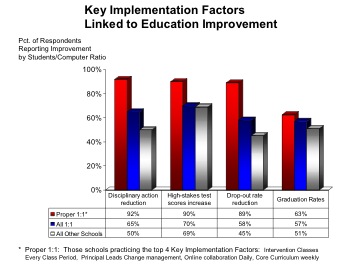Project Red: Do 1:1 right or don't do it at all

Last month, Project Red, an initiative to "Revolutionize Education" through technology, released findings on the utility and factors for success in 1:1 computing. Their research, which spanned almost 1000 schools using a comprehensive survey instrument over the 2009-2010 school year suggested that, when done correctly, 1:1 computing can have measurable and significant impacts on teaching and learning. When done poorly, 1:1 is just an added cost without any added educational value.
Maine was among the first states to roll out 1:1 computing and has been at the forefront of research on its effectiveness, looking at test scores and achievement in a variety of ways. Maine's former governor, Angus King, wrote a foreword to the report, calling Project RED “nothing less than a blueprint for remaking American education...not through more or better testing, charter schools, longer school days, more or even better teachers, but through fundamentally altering how we do education, the first real change in the process of education itself in a thousand years.”
A bit dramatic, perhaps, but for those of us who have seen or experienced the effects of a computer on every desk, the uses of which are woven into an entire school's curriculum, we know that 1:1 really does have the potential to transform how students learn in powerful, relevant ways. Project RED backs this up, calling out 9 key factors that make both a statistically and educationally significant difference in student performance. As the project described in their press release,
The report surveyed 997 schools in school year 2009-2010 on issues related to school leadership, environment, technology implementations, and instructional and financial impact. Questions regarding 22 independent variables provided insight into 11 education success measures, ranging from graduation and dropout rates to high-stakes test scores and paperwork reduction.
All of these data were ultimately distilled to those 9 factors (called Key Implementation Factors, or KIFs in the Project documentation) that need to be present in a school to truly realize the full potential of major 1:1 investments. While each factor is worth a post or two in and of itself, I'll just list them here. You can check out the full set of recommendations from Project RED here.
- Intervention classes: Technology is integrated into every intervention class.
- Change management leadership by principal: Leaders provide time for teacher professional learning and collaboration at least monthly.
- Online collaboration: Students use technology daily for online collaboration (games/simulations and social media.)
- Core subjects: Technology is integrated into core curriculum weekly or more frequently.
- Online formative assessments: Assessments are done at least weekly.
- Student/computer ratio: Lower ratios improve outcomes.
- Virtual field trips: With more frequent use, virtual trips are more powerful. The best schools do these at least monthly.
- Search engines: Students use daily.
- Principal training: Principals are trained in teacher buy-in, best practices, and technology-transformed learning.
Comparing the schools in the survey based on implementation of these factors yields this chart, showing significantly improved outcomes for those schools where all of the KIFs were in place.

The key message? Get computers into every student's hands, use them whenever possible, make sure that teachers and administrators are trained, and, most importantly, ensure that all of your stakeholders have completely bought in to what 1:1 should be. If parents, teachers, and administrators aren't all on board, it will be exceptionally difficult to achieve the 9 factors and make student computers genuinely transformative rather than glorified typewriters.